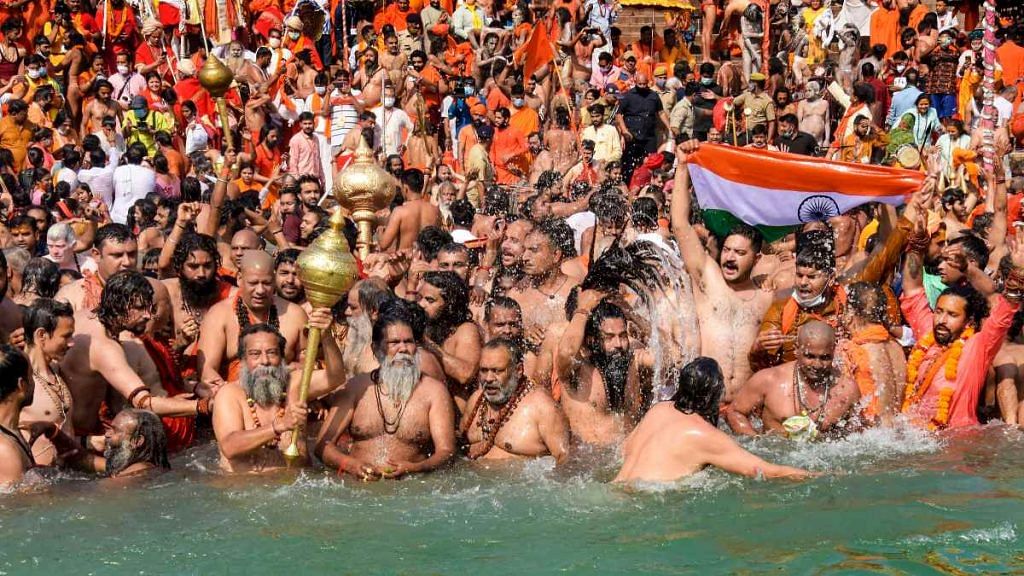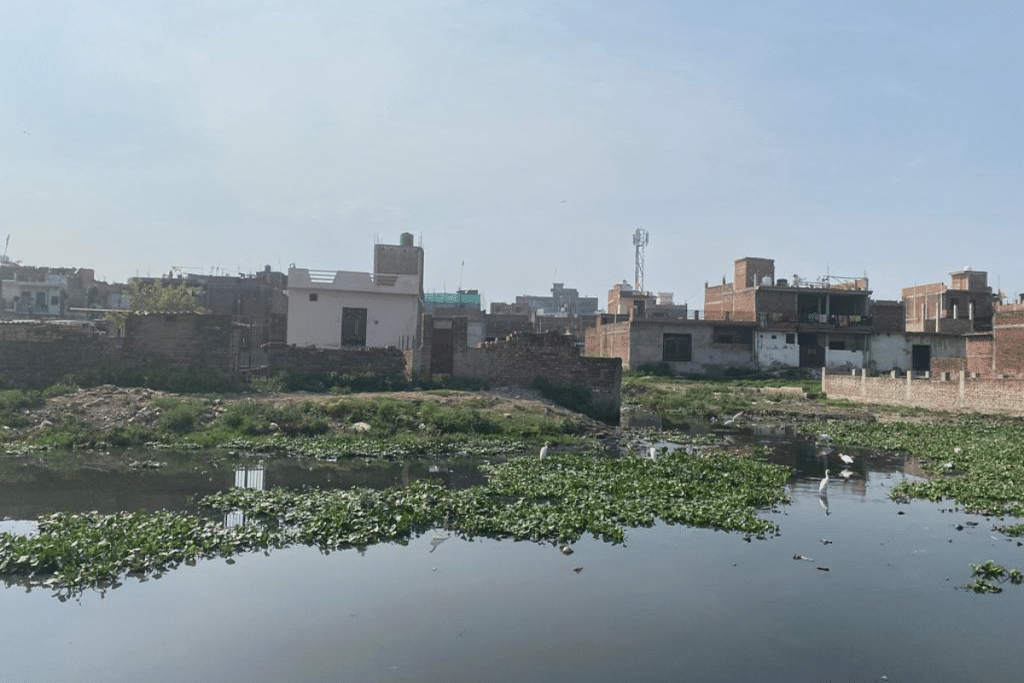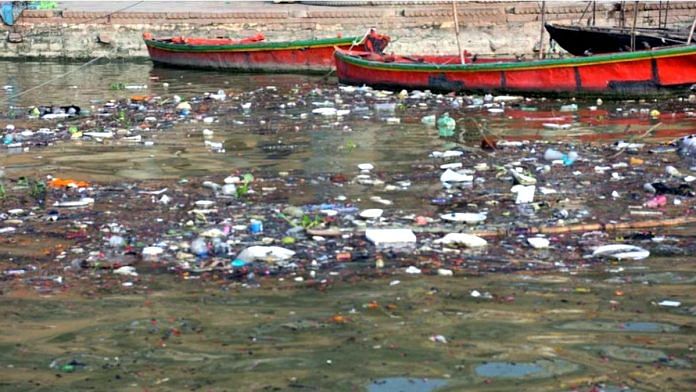New Delhi: On a chilly February morning in 2002, several sadhus across the ghats of the Ganga in Allahabad (now Prayagraj) took a striking decision. They refused to take a dip in the holy river. The sadhus relinquished washing away their sins not because of the freezing cold water, but because of its polluted state.
This incident signalled the beginning of a growing resentment among sadhus and religious figures in Prayagraj towards the state administration’s failure to curb pollution in the river.
The Ganga, winding 2,500 km across northern India, is no mere river, but revered as a goddess, a divine mother. It is entrenched equally in traditional customs and popular culture, even being the centre of Bollywood movies such as Ram Teri Ganga Maili and Jis Desh Me Ganga Behti Hai.
Its desecration with garbage and effluents, therefore, cut deep.
The discontent of sadhus reached a turning point during the Magh Mela in January 2006. They once again boycotted bathing in the polluted waters at the confluence of the Ganga, Yamuna, and mythical Saraswati on the occasion of Makar Sankranti. They also launched a peaceful agitation, demanding the release of pure water into the Ganga from Narora and Tehri dams.
That same month, Swami Harichaitanya Brahmachari Ji Maharaj of Allahabad filed a public interest litigation (PIL) in the Allahabad High Court (HC) in January 2006, marking a significant step in the fight to restore the cleanliness of the Ganga.
In the last 17 years, the high court has issued more than 200 orders on this petition, formed several committees, and even stopped construction within 500 metres of the highest flood level of river Ganga in Allahabad.
The Allahabad HC, however, is not the only judicial institution looking into the Ganga’s pollution.
The Supreme Court was involved in addressing the issue from 1985 until 2017, after which the reins were taken over by the National Green Tribunal (NGT) — a specialised judicial body that handles cases related to environmental issues and disputes.
Presently, the Allahabad High Court as well as the National Green Tribunal are parallelly monitoring the pollution levels in the river.
But, has the Ganga become cleaner?
In February this year, the Union Ministry of Jal Shakti (water resources) claimed that the central government’s Namami Gange programme, launched in 2014, had been “very effective” in cleaning up the river’s water.
However, environment think tank CSE’s magazine Down to Earth reported in April that information it had received under the Right to Information Act revealed that in January this year, at least 71 per cent of the river’s monitoring stations reported alarming levels of faecal coliform.
Sewage overload: Why the Ganga remains polluted despite cleanliness drives
In Uttar Pradesh, over 66 per cent of the 1,340 drains that empty into the Ganga and its tributaries discharge untreated sewage into the rivers.
Know more:https://t.co/zGxa3GjfR3 pic.twitter.com/sZ2IlNgoUa
— CSEINDIA (@CSEINDIA) April 16, 2023
This, said the report, “indicates that the water has been contaminated with the faecal material of humans or other animals, which enters rivers through discharge of untreated sewage”.
These findings suggest that the Ganga remains polluted, despite the persistent judicial efforts spanning over three and a half decades to clean the river.
And within the Allahabad High Court, a new question has emerged after all of these years: which judicial institution should be looking into the Ganga’s pollution? The HC, or the NGT?
The question arose after the Uttar Pradesh government submitted in the Allahabad HC this February that the matter should be transferred to the National Green Tribunal.
ThePrint charts the course of the legal proceedings aimed at restoring the Ganga, as well as the new debate about which court should be in charge.
Also Read: Five reasons that are stopping Ganga from becoming clean
Cycle of festivals — and court orders
From the annual Magh Mela in January-February to the Kumbh and Mahakumbh Mela every six and 12 years respectively, devotees flock to the Ganga to cleanse themselves of their bad karma and sins, seeking liberation from the cycle of rebirths (samsara).
Over the decades, proceedings in the Allahabad High Court have also mirrored the festival calendar, since these events come with an influx of visitors and increased discharge of untreated waste into the river.
In one of its early orders passed in January 2009, the high court noted that the wastewater generated by various camps set up for Magh Mela had become a “perennial problem”, but that the state government was yet to come up with a permanent solution.
The court observed that the pollution in the river is increasing by the day, blaming it on the absence of sewage treatment plants in big cities like Kanpur, Varanasi, and Allahabad on the banks of river Ganga. It observed starkly in the same order that its directions “continue to exist on paper only”.
Fourteen years on, not much has changed.
In an order passed in January this year, the court once again flagged concerns over the discharge of sewage into the river in Prayagraj. It pointed out that the work done to enhance the capacity for sewage treatment in the city was “not commensurate with the increase in population and generation of more sewage”.

It also highlighted in this order how “crores of pilgrims” visit Prayagraj for the Magh Mela, Kumbh, and Mahakumbh, generating extra sewage and solid waste, but that none of the affidavits from the state authorities said anything about “taking care of this additional load on the system”.
In February 2023, the court granted the government more time to examine the issues in detail and submit a report. The court said that the aim was to establish the necessary facilities before the next Mahakumbh, scheduled for December 2023-Janurary 2025.
‘Ganga Views From Your Home’ — or not
Between 2007 and 2023, the high court has issued several orders, pulling up multiple state authorities for concerns ranging from sewage treatment plants, to drains in the city being choked with plastic waste.
Upon the court’s direction after the 2006 PIL, the UP government set up a high-powered committee in 2007, chaired by the chief secretary. This committee was to look into several issues, including setting up treatment plants to prevent wastewater from flowing into the river.
On 13 June 2008, the court also issued a slew of directives for the maintenance of sewage treatment plants in riverside cities, as well as for monitoring tanneries, industries, sugar factories, distilleries, and other manufacturing facilities to curb the discharge of effluents in the Ganga.
In 2009, the court converted the petition to a suo motu plea, and renamed the case as “Re Ganga Pollution”. It also appointed senior advocate Arun Kumar Gupta as amicus curiae to assist the court. Swami Harichaitanya Brahmachari Ji Maharaj’s lawyers, VC Srivastava and Sunita Sharma continued to be a part of the hearings.
Meanwhile, some builders in the city of Prayagraj had a dream — to deliver “Ganga views from your home’ via housing projects, to use the words of the promotional blog for one such proposed endeavor.

In March 2011, another writ petition was filed in the high court against Omaxe Limited and Pancham Realcon Pvt Ltd, seeking to halt the Omaxe Waterfront and Omaxe Sangam City projects, which promised views of the Ganga from houses.
The next month, in April 2011, the HC ordered that no construction could take place within 500 metres of the highest flood level of the Ganga in Allahabad, as well as the part of the Yamuna that adjoins the Ganga at Sangam. This applied not just to private builders but also the Allahabad Development Authority.
Another significant intervention by the HC has been over plastic disposal in the Ganga, a matter that it raised in October and November 2021, and again in December 2022.
In October 2021, for instance, the court observed that the state government had imposed a ban on plastic carry bags in July 2018, but that implementation was lacking. The court directed the commissioner of the Allahabad division to constitute a three-member team to supervise and implement the ban.
‘How can water catch fire?’
The Allahabad High Court is not the only judicial body that has grappled with the issue of pollution in the Ganga.
In April 1985, environmentalist and public interest attorney MC Mehta filed a petition in the Supreme Court, highlighting pollution caused by discharge from various companies, including the Haridwar unit of Bharat Heavy Electricals Limited (BHEL), a public sector undertaking.
Speaking to ThePrint, Mehta said he was driven to act in 1985 after reading a newspaper article, which claimed that a section of the river had caught fire in Haridwar after a matchstick was thrown in a drain.
“I was very surprised and kept thinking, how can water catch fire,” Mehta said, adding he later found out this was because an open drain was dumping toxic effluents into the river, resulting in the water becoming inflammable.
Mehta then filed a petition in the Supreme Court against four industries which were located in Rishikesh, Haridwar, and Dehradun, seeking restrictions on their ability to discharge their untreated or partially treated effluents into waterbodies.
On his petition, the Supreme Court, in September 1987, directed the closure of as many as 20 tanneries that were discharging effluents into the Ganga. In January 1988, the Supreme Court further directed the municipalities concerned to set up sewage treatment plants to prevent untreated domestic sewage from entering the river.
In connection with this case, the apex court also took note of a report from the Comptroller and Auditor General (CAG) of India, which revealed mismanagement and financial irregularities within the Ganga Action Plan, a programme launched by the Rajiv Gandhi government in 1985 to curb pollution in the river.
The CAG report stated that an expenditure of Rs 587.63 crore was incurred on the Ganga Action Plan for the year ending March 2000, but that an audit test check in the states found many instances of financial mismanagement, including funds diversion to unauthorised activities (Rs 36.07 crore), incorrect reporting (Rs 6.75 crore), and funds remaining unutilised with the implementing agencies (Rs 72.62 crores).
Transfer to NGT, ‘judiciary is last hope’
The Mehta case remained with the Supreme Court for several decades until it was transferred to the National Green Tribunal, which was established in 2010 specifically for adjudicating environmental cases.
In 2014, the SC referred the task of monitoring industrial units along the Ganga to the NGT. Subsequently, in 2017, the SC transferred the entire Ganga cleaning and sewage treatment case to the tribunal.
Since then, the NGT has heard the case more than 200 times, issuing orders on various matters such as sewage discharge control, solid waste dumping, illegal sand mining, and water body restoration, amongst others.
The NGT’s orders have encompassed various calls to action, including assessing water quality in multiple states, demarcating floodplains, removing encroachments, setting up biodiversity parks, and handing over floodplains to state forest departments for afforestation and protection.
However, in its last detailed order in July 2022, the NGT lamented that it “found each time that there has been very little progress and nothing to show reduction in pollution level”.
Government records show that a total of 409 projects have been taken up at an estimated cost of Rs. 32,912.40 crore to clean up the river till 31 December 2022.
But even after decades of monitoring, the NGT’s last order says that “nearly 50 per cent of untreated sewage and substantial industrial effluents are continuing to be discharged in the river or its tributaries/drains, in absence of requisite functional treatment capacity”.
Meanwhile, despite the fact that Ganga remains polluted, Mehta is still hopeful that the judiciary can bring about a change.
“When the state fails to take steps and the industries feel that they are above the law, then the judiciary is the only last hope,” he told ThePrint. “During the night, even one jugnu (firefly) can light up the entire place.”
Who gets to clean up Ganga?
Seventeen years after the Allahabad High Court took up the matter of cleaning up the Ganga, a new question was posed before it: does the case even come under its jurisdiction?
In a 22 February order this year, the HC noted that the Uttar Pradesh government had argued that the matter should be heard by the NGT instead.
To make this submission, the state government relied on a 2012 Supreme Court judgment, which directed that all environment-related cases filed after the enactment of the National Green Tribunal Act 2010 should be transferred to the NGT. The SC had noted that this would help avoid conflicting orders from the NGT and high courts.
As for environment-related cases that were filed prior to the NGT Act, the Supreme Court in 2012 only had a word of “caution for consideration of the courts”. It said that “the courts may be well advised to direct transfer of such cases to the NGT in its discretion, as it will be in the fitness of administration of justice”.
During the latest hearing of the Ganga case in the HC on May 1, the UP government and a lawyer representing builder Omaxe argued in favour of transferring the case to the NGT, said a lawyer associated with the proceedings.
Speaking to ThePrint on condition of anonymity, the lawyer said that the high court has reserved its order on the question of whether it should transfer the matter to the NGT.
He also highlighted practical difficulties with such a transition.
“The case has accumulated more than 10,000 pages of records, and sending the matter (to the NGT) at this point, will create an analogous situation,” he explained.
“The 2006 case proceedings have obstructed huge development projects along the river basin in Allahabad. Therefore, private stakeholders as well as the government want the matter to move out of the Allahabad High Court. Once the files move out, they are hopeful that the stay (passed in 2011) may also lose its significance,” the lawyer claimed.
Senior advocate Arun Kumar Gupta, who was appointed as amicus curiae in the case in 2007, told ThePrint that the court has not yet heard his views regarding the transfer.
He, however, expressed his reservations to ThePrint. “The problem is that these officers don’t want this case to continue. Carry out development in every corner of the world, why do you want to do it only on the banks of Ganga?” he said.
Gupta also said he believes that the transfer of this case “will be against public interest at large”.
“The hon’ble high court is monitoring this case very closely and several steps are being taken by the state government and their officers for cleaning the river. However, nearly 15 crore people took a bath (in the Ganga) in the last Kumbh. In the upcoming Mahakumbh in 2025, this number is expected to increase,” he pointed out.
“The government should first comply with all the orders of the high court,” Gupta added. “Why does it want to run away?”
(Edited by Asavari Singh)



